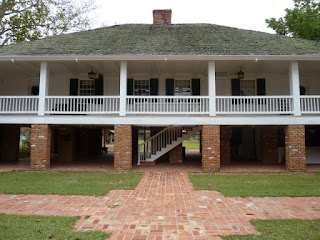Louisiana was my first stop after leaving Austin. I spent the night in city then the next morning took a very pleasant jog through its historic district. Unlike the "historic districts" in a lot of towns I've passed through, this one was actually quite large and nearly all of the buildings dated from before the turn of the 20th century. Lots of homes with big windows and big porches, and a lot of decorative flourishes.
My first and only "real" stop in Louisiana was at
Kent Plantation House in the central part of the state. What was once a 500-acre planation is now down to a few acres, with the original house and a few relocated outbuildings.
 |
| Slave quarters & kitchen |
Did you know that there were middle class plantations? Neither did I, until this visit. But apparently there were, and this was one of them.
 |
| The original plantation. Wings on each side (not in the photo) were added later. |
As far as the actual buildings went, I didn't think this was the most interesting of house tours. But I thought the guide was really informative. Touring this house was more like attending a lecture called "Did you know ...? Mid-19th Century America Edition." than going on a typical house tour. I learned everything from how folks in the olden days kept the bugs off their furniture (they sat the legs in bowls of water, which meant that every so often the bottoms of the legs had to be sawed off, creating shorter and shorter furniture as time went on) to why baby christening gowns were pleated horizontally (so that as the baby grew taller, the pleats could be let out to make the dress longer). And did you know that there were free black people in the old south
who owned slaves?! My favorite tidbit: Learning that "Cajun" is a derivative of "Acadian" -- the french people who were
kicked out of eastern Canada by the English.
 |
| Inside the kitchen house |
 |
| The master bedroom, looking dark and creepy like a proper Louisiana plantation. |
Interesting story about the house: It's the only remaining antebellem plantation in central Louisiana. Apparently, during the Civil War, and the North was either retreating or was conquering (I don't remember which), the army burned everything in its wake. But when they arrived at the name plantation, the owner and his wife and family refused to leave the house, saying the army would have to burn them too if they wanted to set fire to the house. The army's leader did not want to kill civilians, so they let the house stand. look this up
 |
| Inside the slave quarters |
In case you're wondering why I didn't spend more time in Louisiana or visit the very famous New Orleans, it's because I've been there twice. New Orleans seems really cool (at least during the
New Orleans Jazz and Heritage Festival) but I didn't feel I needed to stop there on this trip too, when there were new things I could see.





No comments:
Post a Comment